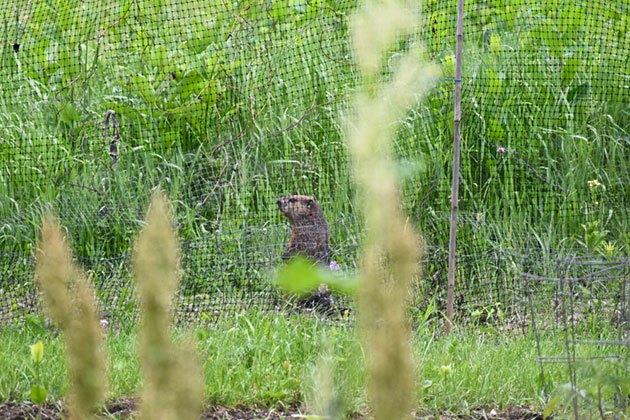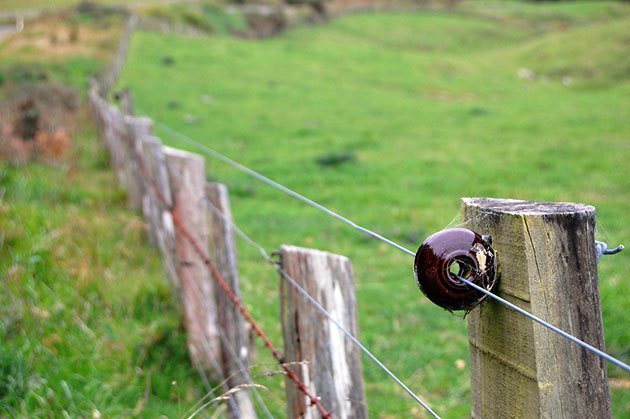Are you a gardener striving to create a beautiful garden and make others envious?
If you are, you certainly want to prevent groundhogs, raccoons, squirrels, rabbits, and other nuisance animals from intruding.
It doesn’t seem easy, but it’s possible to use an electric garden fence for groundhogs.
A groundhog fence will prevent garden pests from damaging your garden and avoid digging in your vegetable garden, flower beds, etc.
However, it can also keep wild animals from reaching your farm and threatening other animals.
Is fencing successful? Let’s see.
Are groundhogs annoying?

Also known as woodchucks, groundhogs are common in suburban areas.
They can easily dig holes in your yard, chew on veggies and fruits in your garden, or damage your flower beds.
Woodchucks can also eat more than 1.5 pounds of vegetation every day, causing damage to grass, plants, and soil in hours.
You can find them in open areas during the growing season to quickly jump and escape from any danger.
How do you recognize groundhogs?
For those who don’t know what animal created a massive mess in the garden, here are signs that these most probably were woodchucks:
- wide teeth marks
- woodchuck burrow entrances
- claw marks on trunks of trees and stems on fruit
- damage to grass, plants, and earth
- four-clawed tracks in the dirt for front paws and five in the back for rear feet.
So, the best method to prevent groundhogs from digging into your gardens is to set up an effective electric fence for groundhogs.
Before you start installing an electric fence for groundhogs
Here are the basic steps for an excellent start:
- Check with local authorities if you’re allowed to install a solar-powered fence.
- Determine what wild animals you’re going to deter.
- Does your garden already have an existing fence around its perimeter? What’s the fencing made of? It will help you to determine the type of required insulators.
- What is the total perimeter of your garden? You will determine the precise amount of wire strands and insulators.
- How many gates do you have to enter the garden quickly?
- How many corners are around your garden perimeter?
- How long will you use the fencing for groundhogs?
Once you determine the suitable animal type (woodchuck, deer, squirrel, rabbit) & all other answers, you can choose the best electric fences for groundhogs.
What are the required components?

Based on the tips above, you will need the following garden fence equipment:
- 17-gauge galvanized fence wire
- a low-impedance charger
- insulators – yes or no, depending on the fence posts
- rubber gate handle
- 100 feet of ground wire
- electric fence tester
- warning sign for the fencing
- pressure-treated wood post – 4x4x8 inches
- six-feet copper-clad ground steel rod, 0.5-inch in diameter, with a clamp.
These are optional requirements based on farmers’ experiences and suggestions.
If you have a different idea and different needs, don’t hesitate to adjust your construction according to your requirements.
You may or may not need all these units, so check the instructions below for an alternative.
Installing electric fencing: Another option
Electric fences are the best solution to stop groundhogs before destroying your gardens.
The groundhog fence will make them uncomfortable with a shock, conditioning enough to keep groundhogs away and teach them not to enter the garden again.
However, to properly install and use the groundhog fence, you will need a suitable groundhog fence kit as another option for setup.
It comes with all tools and components necessary for the correct setup process.
The groundhog fence kit includes the following elements:
- hookup wire
- ground rod
- step-in insulated fence posts
- reel of electric fence wire
- C electric fence charger
However, if you want an effective groundhog fence, you must purchase the same units. The system will allow you to choose the best accessories as well.
For example, if you want to use a solar-powered fence charger, you can pick multiple wire models, such as poly wire, poly tape, aluminum wire, etc.
If the fence posts are not already insulated, you will need to obtain insulators for proper and stable wire strands.
Remember, your feces for woodchucks must be at least 6 feet tall to prevent groundhogs from jumping over and climbing up.
Groundhogs will give up climbing, yet many farmers complain they are persistent and still climb.
If it’s still not adequate, you can try with the stainless steel wire mesh barriers, ideal for birds, and you can moderate it to protect your land.
Installing electric fencing: The best procedure

When setting an ideal groundhog fence, don’t forget to use one wire and place it four inches above the ground.
The first wire is crucial, as the groundhogs efficiently tunnel and jump under the electric fencing. If you want to prevent this, pay attention to the first wire.
Another excellent solution for a productive groundhog fence is to implement two deterrents.
Firstly, you need to set up a solar-powered fence around the garden.
Secondly, to avoid digging under the fencing, you can surround the fence with wire mesh buried some inches underground.
You can also apply the fence wire twelve inches along the fence to keep pests from coming into the restricted area.
You may need more or less time to install and apply the fencing.
Many farmers agree that the most challenging part might be digging the hole for the fence posts and ground rods.
Another step is to charge the fence charger. You can set it under direct sunlight and place it there for three days before use.
You can also place insulators on your existing fencing, but first, calculate their height from the ground.
Depending on the type of posts – from plastic to metal ones, you may or may not need insulators.
For steel posts, you can apply rod-post insulators. However, for vinyl-coated fences, you can use chain-link fence insulators. They should be installed approximately six feet apart.
At this point, you will need a ruler. Use it to determine the six inches of distance from the ground before you install the insulator.
The next step is to measure the corner. Then, again, you can apply chain-link or wrap-around insulators, depending on the posts.
Next off, run the wire around the fence to keep pests away from the garden.
You can start the installation on one side of the gate and run the fence wire around the fence’s circumference to reach the other side.
You will need a single strand of wire for the complete circumference.
Another point is to install the gate handle. So, you will have to measure twelve inches of a wire piece and keep it attached to the spool.
Then fold the wire in half to six inches. Finally, fold these halves into halves of three inches.
Finally, make a loop with pieces of three inches by twisting the bottom of the wire around itself. You will get a circle for the gate handle.
Your next step is to wrap the fence around the circumference and each insulator. Again, keep the wire taut around the fence.
You will complete the process and secure the wire to the other end of the gate to finish the procedure.
Next, you must dig a hole to place the ground rod inside and ensure the animals get their shocks properly. It has to be at least 5 feet into the ground.
Then, connect the ground wire, but ensure the charger is turned off. However, you can alternate hot and grounded wires as you go up to the poles.
Finally, it would be best if you hung the warning size and did the regular maintenance of the fence to keep the voltage levels optimal and productive for animals.
However, if you find that your fence meshing is not as tight as possible, you can fix it via wiring a section of chicken wire onto the bottom part of the existing structure and solving the issue.
What are potential issues?
Woodchuck burrow systems are among the most significant issues in agriculture, as they can damage farm machines once they run over them.
In addition, many horse owners claim that their horses easily tip over woodchuck burrows and get injured.
However, many states that even farmers tip over woodchuck burrows and quickly get hurt.
Also, you must pay attention to the timing, or your effort will be in vain.
Before eradicating woodchucks, remember that breeding female woodchucks place their young woodchucks into the burrows from late winter to spring or summer.
So, the foremost expert advice is to leave them alone until the breeding is over.
However, as woodchucks hibernate, they are unlikely to do any damage between November and February.
In that period, other animals might cause damage to your garden, including deer and rabbits.
Thus, you should consider different fences and their sizes to prevent significant pests such as deer and elk, or small ones like squirrels, etc., and protect your garden from harm.
As mentioned earlier, you must clean the groundhog fence from all potential issues.
Although fall and winter are not as rich as summer and spring in terms of herbs and vegetation, you still have to remove potential herbs to prevent low-voltage pulses.
When talking with experienced farmers, they will confirm my guidelines.

Can you get rid of woodchucks?
Yes, you can. A groundhog is afraid of new objects in your yard, so you can use various things to scare them off.
You can close the burrow the woodchucks made. Then, monitor the burrows for a couple of days to ensure they’re not occupied.
When you’re confident the burrow is empty, seal it permanently. Monitor other burrows and your whole backyard.
Once you fill and close the existing burrows, woodchucks will instantly create a new one, and when you close the new burrow for good.
So, prevent a popping burrow for less labor.
Another solution to keep the animal away after you’ve installed the woodchuck fence is to use the woodchuck repellents.
The repellents are natural, and they hate these smells: oregano, lemon balm, rosemary, thyme, sage, mint, chives, and basil.
Finally, you can try planting lavender around your garden or the installed fence. It will smell lovely to humans, but groundhogs will find it offensive.
Therefore, they will avoid these areas and stay away from your property.
Conclusion
I think we’ve covered all crucial parts regarding the electric garden fence for groundhogs.
Many agree that woodchucks are not valuable to farmers, but they do have their own place in nature, and we should respect them.
However, we cannot respect them when they climb over the fences and eat our vegetation, leaving dirt and damage after the visit.
So, if you think electric fencing is a valuable solution for these pests, feel free to build one, but follow the main guidelines for successful protection.
Let me know your impressions and experience!
